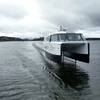Training Tips for Ships - Tip #18: Creating a Culture of Learning
We all think about how to train to produce better outcomes – because better training outcomes mean better performance, safer operations, and employees who are more engaged and more satisfied. But there is a much “bigger picture” goal that only the most thoughtful of maritime organizations work to achieve.
- That goal is to create a “culture of learning”.
It is a little hard to express a concrete definition for a culture of learning, but it is amazing how clear and powerful it is when you experience it. In an organization with a strong learning culture, personal and professional development are an ongoing part of the job. They are intrinsic to what the company does and incorporated into each employee’s job description. Training is not something that is treated as a periodic hurdle to jump over and leave behind as quickly as possible. Instead, learning is a continuous, valued process engaged in daily, throughout each person’s career. Most importantly, although a strong learning culture could be viewed as a set of policies, it is really a company value held and promoted throughout the organization which influences every decision including hiring, operations, promotion, sales, and more.
So many of the benefits of a strong learning culture are self-evident. But let’s talk about a few of them here. First, it has been shown over and over that organizations with strong learning cultures perform very highly for employee engagement and retention. The often-heard argument that investing in an employee’s training simply benefits the next organization he or she works for does not hold in practice. Instead, continuous investment in employee training and development tends to create a dedicated, long-term employee base. That is incredibly valuable. Strong learning cultures are also synonymous with employees who pride themselves on professionalism, safety and performance.
Additionally, strong learning cultures tend to perpetuate themselves once they are established. An operator, once known for its focus on learning, will attract job applicants with compatible values. These are applicants who care about their career and their performance and wish to develop themselves professionally. Candidates who dislike training and are professionally disengaged are unlikely to apply to work at such a company. Similarly, during the transition to a culture of learning, it is possible that employees without a strong professional drive may leave as they find the new company culture at odds with their values. Together, this means that over the course of years, the company’s professionalism and learning culture will only strengthen, and that safety and performance will continue to improve.
So the big question is, how do we implement a culture of learning? There are many answers to this. First and foremost, the people at the top of the organization must both communicate and demonstrate their own commitment to learning. This is paramount and must come before all else. In addition, there are a common set of techniques that are shared by companies with a strong learning culture. For example, companies with the strongest learning cultures involve everyone in the management of the learning process.
From the bottom employee to the top, each person has a say not only in their own development (which is important), but also in how learning can evolve and improve throughout the organization. All but the newest employees can act as a learning mentor to one or more other employees. All learning planning committees should have broad and inclusive membership from employees at every level, and from a diverse set of departments. These committees are informed by regular employee polls and other forms of input from the employee base. Communication and transparency regarding corporate learning values, decisions, successes, failures, and changes should be prominent and continuous. Plus, of course, the approach to learning must be continually measured and updated as part of a continuous improvement process.
There are so many parts to this, and each organization will be different in their details of implementation, but the pillars are leadership from the top, communication, transparency, and the involvement of every employee in the management and direction of learning.
There is much more that needs to be said, and will be said, on this topic in future training tips for ships. In the meantime, keep healthy and sail safely.













